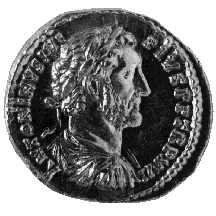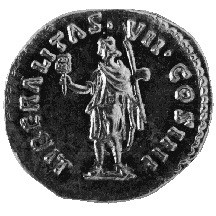



(96) Antoninus Pius - AV aureus, A.D. 152-153, 7.24 g. (inv. 91.171).
Obverse: Laureate, draped, and cuirassed bust of Antoninus
Pius r.; ANTONINVS AVG(VSTVS) PIVS P(ATER) P(ATRIAE) TR(IBVNICIA) P(OTESTATE)
XVI: Antoninus Augustus Pius, father of the country, with tribunician power
for the sixteenth time.
Reverse: Liberalitas standing l., with four-dotted tessera
(?) in r. and vindicta in l.; LIBERALITAS VII CO(N)S(VL) IIII: seventh
liberality, consul for the fourth time.
Provenance: Abner Kreisberg, 1970.
Bibliography: H. Mattingly and E.A. Sydenham, The Roman
Imperial Coinage III: Antoninus Pius to Commodus (London 1930) 229;
C. Foss, Roman Historical Coins (London 1990) 131 no. 76a.
Hadrian adopted Antoninus Pius as his heir in A.D. 138, compelling him in
turn to adopt Marcus Aurelius and Lucius Verus, who were too young to be
made direct successors. Hadrian died the same year, and Antoninus convinced
the Senate to consecrate his predecessor as divine (hence, probably, the
name Pius, "faithful to familial obligations"). Antoninus's reign,
unlike those of his successors, was relatively free from war, although there
were uprisings in Dacia, Germany, and Britain.
On the obverse, Antoninus, who took up Hadrian's custom of wearing a full
beard, resembles a Greek philosopher. Although traditionally scholars distinguish
three portrait bust types for Antoninus, all of his numismatic portraits
seem to conform to the first of these, which is distinguished by a full
head of wavelike hair, with three central locks over the forehead (most
likely a reference to Augustus).
This coin commemorates the seventh of Antoninus's nine congiaria
or liberalities, distributions of money to individuals on a dole list. This
particular congiarium marks his fifteenth anniversary as emperor.
Such gifts of money are commonly celebrated on Roman coinage, but only with
Hadrian, in whose footsteps Antoninus often follows, does the named personification
Liberalitas appear. The exact nature of the object that Liberalitas holds
in her right hand is unclear. The most likely explanations are that it is
an abacus, used in apportioning the coinage; a tessera or tile, bearing
the list of recipients of the congiarium; or a scoop for obtaining
coins from the pile. The vindicta is the rod characteristic of Libertas,
the personification of individual freedom; here Liberalitas may be confused
(as she is elsewhere) with Libertas.
M.D.P.



All contents copyright (c) 1996.
Lawrence University
All rights reserved.